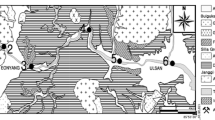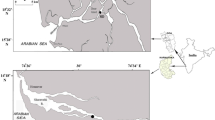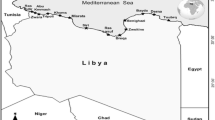Abstract
Cu, Cr, Fe, Mn, Ni, Pb, and Zn in the sediments of the Kabini River, Karnataka, India was studied to determine the association of metal with various geochemical phases by sequential extraction. The variations of heavy metal concentration depend on the lithology of the river basin and partly on anthropogenic activities. The Kabini River sediments are dominated by Sargur supracrustals with amphibolites, gneisses, carbonates, and ultrabasic rocks weathering into gneissic and serpentine soils carrying a natural load of cationic heavy metals. The source of heavy metals in the Kabini riverbed sediments is normally envisaged as additional inputs from anthropogenic over and above natural and lithogenic sources. Geochemical study indicates the metals under study were present mostly in the least mobilizable fraction in the overlying water and it is concluded that heavy metals in these sediments are to a great extent derived from multisource anthropogenic inputs besides geochemical background contributions The results show that lead and chromium have higher potential for mobilization from the sediment due to higher concentration at the exchangeable ion and sulfide ion bounded, also Cu and Pb have the greatest percentage of carbonate fraction, it means that the study area received inputs from urban and industrial effluents. Association of the Fe with organic matter fraction can be explained by the high affinity of these elements for the humic substances. Further, Zn and Ni reveal a significant enrichment in sediment and it is due to release of industrial wastewater into the river. These trace metals are possible contaminants to enter into aquatic and food chain.



Similar content being viewed by others
References
Ahumada, I., Mendoza, J., & Ascar, L. (1999). Sequential extraction in soils irrigated with wastewater. Communications in Soil Science and Plant Analysis, 30, 1057–1519.
Aloupi, M., & Angelidis, M. O. (2001). Geochemistry of natural and anthropogenic metals in the coastal sediments of the island of Lesvos. Aegean Sea. Environment Pollution, 113(2), 211–219.
Alves, J. P. H., Passos, E. A., & Garcia, C. A. B. (2007). Metals and acid volatile sulde in sediment cores from the Sergipe River Estuary, Northeast Brazil. Journal of the Brazilian Chemical Society, 18, 748–758.
Chandra Sekhar, K., Chary, N. S., Kamala, C. T., Suman Raj, D. S., & Sreenivasa Rao, A. (2004). Fractionation studies and bioaccumulation of sediment-bound heavy metals in Kolleru lake by edible fish. Environment International, 29(7), 1001–1008.
Chester, R., & Hughes, M. J. (1967). A chemical technique for the separation of ferromanganese minerals, carbonate minerals and adsorbed trace element from pelagic sediments. Chemical Geology, 2, 249–262.
Chiu-Wen, C., Chih-Ming, K., Chih-Feng, C., & Cheng-Di, D. (2007). Distribution and accumulation of heavy metals in the sediments of Kaohsiung Harbor, Taiwan. Chemosphere, 66(8), 1431–1440.
Dean, J. R. (2002). Methods for environmental trace analysis. New York: Wiley.
Evans, G., Howarth, R. J., & Nombela, M. A. (2003). Metals in the sediments of Ensenada de San Simo´n (inner Rı´a de Vigo), Galicia, NW Spain. Journal Applied. Geochemistry, 18, 973–996.
Gambrell, R. P., Reddy, C. N., & Khalid, R. A. (1983). Characterization of trace and toxic materials in sediments of a lake being restored. Journal of Water Pollution Control Federation, 55(9), 121–1210.
Gholami, S., & Srikantaswamy, S. (2009). Statistical multivariate analysis in the assessment of river water quality in the vicinity of KRS Dam, Karnataka, India. Natural Resources Research. doi:10.1007/s11053-009-9096-y.
Gibbs, R. J. (1977). Transport phases of transition metals in the Amazon and Yukon river. Geological Society of America Bulletin, 88, 829–843.
Jain, C. K. (2004). Metal fractionation study on bed sediments of River Yamuna. India, Water Research, 38, 569–578.
Jain, C. K., Malik, D. S., & Yadav, R. (2007). Metal fractionation study on bed sediments of Lake Nainital, Uttaranchal, Índia. Environmental Monitoring and Assessment, 130, 129–139.
Jain, C. K., Harish, G., & Chakrapani, G. J. (2008). Enrichment and fractionation of heavy metals in bed sediments of River Narmada. India. Environmental Monitoring Assessment, 141(1–3), 35–47.
Jenne, E. A. (1968). Controls on Mn, Fe, Co, Ni, Cu and Zn concentrations in soils and water: the significant role of hydrous Mn and Fe oxides. Advances in Chemistry Series, 73, 337–388.
Karbassi, A. R., & Shankar, R. (2005). Geochemistry of two sediment cores from the west coast of India. International Journal of Environmental Science and Technology, 1(4), 307–316.
Liaghati, T., Preda, M., & Cox, M. (2003). Heavy metal distribution and controlling factors within coastal plain sediments, Bells Creek catchment, southeast Queensland, Australia. Environment International, 29(7), 935–948.
Lu, Y., & Allen, H. E. (2001). Portioning of copper onto suspended particulate matter in river waters. Science Total Environment, 277(1–3), 119–132.
Ma, L. Q., & Rao, G. N. (1997). Chemical fractionation of cadmium, copper, nickel, and zinc in contaminated soils. Journal of Environmental Quality, 26, 259–264.
Matthieu, M., Gérard, B., & Jörg, S. (2006). Geochemical signals and source contributions to heavy metal (Cd, Zn, Pb, Cu) fluxes into the Gironde Estuary via its major tributaries. Science of the Total Environment, 370(1), 133–146.
Morgan, J. J., & Stumm, W. (1991). Chemical processes in the environment, relevance of chemical speciation. In E. Merien (Ed.), Metals and their compounds in the environment (pp. 67–103). Germany: VCH.
Mueller, G. (1979). Schwermetalle in den sediments des Rheins- Veranderungen Seitt. mschan, 79, 778–783.
Relic, D., Dordevic, A., & Popovic Blagojevic, T. (2005). Speciation of trace metals in the Danube alluvial sediments within an oil refinery. Environmental Pollution, 3, 661–669.
Sakan, S., Grñeti, I., & Worpevi, D. (2007). Distribution and fractionation of heavy metals in the Tisa (Tisza) River sediments. Environmental Science and Pollution Research, 14, 229–236.
Santos, I. R., Silva-Filho, E. V., Schaefer, C. E. G. R., Albuquerque-Filho, M. R., & Campos, L. S. (2005). Heavy metal contamination in coastal sediments and soils near the Brazilian Antarctic Station, King George Island. Marine Pollution Bulletin, 50(2), 185–194.
Sharma, S. D., & Pandey, C. P. (1998). Pollution studies on Ramaganga river at Moradabad physico-chemical characteristics and toxic metals. Pollution Research, 17(2), 201–209.
Singh, K. P., Mohan, D., Singh, V. K., & Malik, A. (2005). Studies on distribution and fractionation of heavy metals in Gomti river sediments—a tributary of the Ganges, India. Journal Hydrology, 312, 14–27.
Tessier, A., Campbell, P. G. C., & Bisson, M. (1979). Sequential extraction procedure for the speciation of heavy metals. Analytical Chemistry, 51(7), 844–861.
Xiangdong, L., Zhenguo, S., Onyx, W. H. W., & Yok-sheung, L. (2000). Chemical partitioning of heavy metal contaminants in sediments of the Pearl River Estuary. Chemical Speciation and Bioavailability, 12, 17–25.
Acknowledgments
The authors are thankful to Mr. Poolad Daneshvar for help in statistical data treatment in this research work. The authors also thank Prof. S. Sathyanarayan and Dr. A. Karbassi for their guidance and useful discussion during the course of the preparation of this paper.
Author information
Authors and Affiliations
Corresponding author
Rights and permissions
About this article
Cite this article
Hejabi, A.T., Basavarajappa, H.T. Heavy metals partitioning in sediments of the Kabini River in South India. Environ Monit Assess 185, 1273–1283 (2013). https://doi.org/10.1007/s10661-012-2631-z
Received:
Accepted:
Published:
Issue Date:
DOI: https://doi.org/10.1007/s10661-012-2631-z




